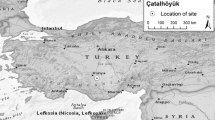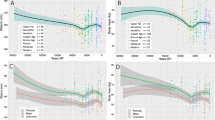Abstract
Demography is the study of human population dynamics including deaths, births, and migrations. Statistical analysis can help researchers understand paleodemographic patterns of health, mortality, and morbidity among ancient populations. Generally speaking, population is affected by both the natural environment and social conditions. This research is based on six archaeological cemetery sites located in Heilongjiang, Inner Mongolia, and Shanxi Provinces in northern China, temporally spanning from the Bronze Age to the early Iron Age (about 1000 BC–200 BC). This study demonstrates how subsistence patterns influence the population in the north of ancient China. The results show that the mortality rate of the population groups that relied on animal husbandry peaks much earlier than among the agricultural groups; the estimated life expectancy of members of the agricultural economy group is longer than that of those in the animal husbandry group; and the animal husbandry group shows a relatively larger sex imbalance.





Similar content being viewed by others
References
Chen, Quanjia 陈全家 2007. “Neimenggu Linxi xian Jinggouzi yi zhi xi qu mu zang chu tu de dong wu yi cun yan jiu 内蒙古林西县井沟子遗址西区墓葬出土的动物遗存研究 (research on animal bones excavated from the Jinggouzi western sector cemetery, Linxi County, Inner Mongolia).” Neimenggu wen wu kao gu 内蒙古文物考古 2007.2: 107–118.
Espinoza, P.O.H., and L.M. Morfin. 2015. Maya paleodemographics: What do we know? American Journal of Human Biology 27 (6): 747–757.
Fan, Wenqian 范文谦, Tian, Jianwen 田建文, Xie, Xiaoting 谢尧亭, Wang, Jinping 王金平 2002. “Shanxi Houma shi Siqu mu di de fa jue 山西侯马市虒祁墓地的发掘 (Excavation of the Siqi cemetery ,Houma, Shanxi)”. Kao gu 考古 2002.4: 41–59, 99-103.
Gu, Yucai 顾玉才 2010. “Neimenggu Helingeer xian Tuchengzi yi zhi Zhanguo shi qi ren gu yan jiu 内蒙古和林格尔县土城子遗址战国时期人骨研究 (research on human skeletons of the warring states period from the Tuchengzi site, Horinger County, Inner Mongolia). Beijing: Ke xue chu ban she.
Heilongjiang. 1990. Heilongjiang sheng wen wu kao gu yan jiu suo 黑龙江省文物考古研究所 (1990). In Pingyang mu zang 平洋墓葬 (The Pingyang cemetery). Beijing: Wen wu chu ban she.
Jilin 2004 Jilin da xue bian jiang kao gu yan jiu zhong xin 吉林大学边疆考古研究中心 and Neimenggu wen wu kao gu yan jiu suo 内蒙古文物考古研究所 (2004). “2002 nian Neimenggu Linxi xian Jinggouzi yi zhi xi qu mu zang fa jue ji yao 2002年内蒙古林西县井沟子遗址西区墓葬发掘纪要 (Notes on the 2002 excavations of the western sector cemetery of the Jinggouzi site, Linxi County, Inner Mongolia).” Kao gu yu wen wu 考古与文物 2004.1: 6–19.
Nagaoka, Tomohito, Sawada Junmei, and Hirata Kazuaki. 2013. Demographic and pathological characteristics of the medieval Japanese: New evidence from human skeletons from Kamakura, Japan. Anthropological Science 121 (3): 203–216.
Pan, Ling 潘玲 and Lin, Yun 林沄 2002. “Pingyang mu zang de nian dai yu wen hua xing zhi 平洋墓葬的年代与文化性质 (the date and cultural nature of the Pingyang cemetery). Bian jiang kao gu yan jiu 边疆考古研究 1: 194–203.
Pan, Qifeng 潘其风 1990. “Pingyang mu zang ren gu de yan jiu 平洋墓葬人骨的研究 (research on human bones from the Pingyang cemetery).” In Heilongjiang sheng wen wu kao gu yan jiu suo 黑龙江省文物考古研究所, Pingyang mu zang,平洋墓葬 (The Pingyang cemetery), pp. 187–235. Beijing: Wen wu chu ban she.
Pan, Qifeng. 1994. Shangma mu di chu tu ren gu de chu bu yan jiu 上马墓地出土人骨的初步研究 (preliminary research on human bones from the Shangma cemetery). In Shanxi sheng kao gu yan jiu suo 山西省考古研究所, Shangma mu di 上马墓地 (The Shangma cemetery), 398–483. Beijing: Wen wu chu ban she.
Pan, Qifeng. 2000. Tianma-Qucun yi zhi xi Zhou mu di chu tu ren gu de yan jiu bao Gao 天马—曲村遗址西周墓地出土人骨的研究报告 (research report on human bones unearthed from the Tianma-Qucun western Zhou dynasty cemetery). In Beijing da xue kao gu xi Shang Zhou zu 北京大学考古学系商周组, Shanxi sheng kao gu yan jiu suo 山西省考古研究所 (authors), and Zou Heng 邹衡 (editor), Tianma-Qucun 天马-曲村 (The Tianma-Qucun site), 1138–1152. Beijing: Ke xue chu ban she.
Shang, Xiangqing 邵象清 1985. Ren ti ce liang shou ce 人体测量手册 (anthropometry handbook). Shanghai: Shanghai ci shu chu ban she.
Shangma 1990 Shanxi sheng kao gu yan jiu suo (1990). Shangma mu di 上马墓地 (Shangma cemetery). Beijing: Wen wu chu ban she.
Walter, Brittany S., and Sharon N. DeWitte. 2017. Urban and rural mortality and survival in medieval England. Annals of Human Biology 44 (4): 338–348.
Wang, Lusi 王路思 2014. “Houma gong lu huo yun shu niu zhong xin Siqi mu di ren gu yan jiu 侯马公路货运枢纽中心虒祁墓地人骨研究 (research on human bones from the Houma Gonglu transport hub center Siqi cemetery).” M.A. thesis, Jilin University.
White, Andrew Allen. 2014. Mortality, fertility, and the OY ratio in a model hunter-gatherer system. American Journal of Physical Anthropology 154 (2): 222–231.
Wu, Rukang 吴汝康, Wu, Xinzhi 吴新智, and Zhang, Zhenbiao 张振标 1984. Ren ti gu ge ce liang shou ce 人体骨骼测量手册 (handbook on the measurement of human bones). Beijing: Ke xue chu ban she.
Xindianzi 2009 Cao Jianen 曹建恩, Sun Jinsong 孙金松, and Hu Xiaonong 胡晓农 (2009). “Neimenggu Helinggeer xian Xindianzi mu di fa jue jian bao 内蒙古和林格尔县新店子墓地发掘简报 (short report on the excavation of the Xindianzi cemetery, Horinger County, Inner Mongolia).” Kao gu 2009.3: 3–14.
Zhang, Quanchao 张全超 2005. Neimenggu Helingeer xian Xindianzi mu di ren gu yan jiu 内蒙古和林格尔县新店子墓地人骨研究 (research on human bones from Xindianzi cemetery, Horinger County, Inner Mongolia). Ph.D dissertation, Jilin University.
Zhang, Quanchao 张全超, Jacquelin T. Eng, Wang, Lixin 王立新, and Ta La 塔拉 2008. “Neimenggu Linxi xian Jinggouzi xi qu mu di ren gu de wen ding tong wei su fen xi 内蒙古林西县井沟子西区墓地人骨的稳定同位素分析 (Paleodiet studies using stable carbon isotopes from human bone: Example from the Jinggouzi cemetery, Linxi County, Inner Mongolia).” Bian jiang kao gu yan jiu 7: 322–327.
Zhao, Yubao 赵玉宝 2005. Xian Qin xing bie jiao se yan jiu 先秦性别角色研究 (gender roles in the pre-Qin period). Ph.D dissertation, Northeast Normal University (China).
Zhu, Simei 朱思媚 and Liu, Ming 刘铭 2014. “Neimenggu Linxi xian Jinggouzi yi zhi xi qu mu zang chu tu ren gu de ren kou xue yan jiu 内蒙古林西县井沟子遗址西区墓葬出土人骨的人口学研究 (Demographic research on human bones of the western sector cemetery of the Jinggouzi site in Linxi County, Inner Mongolia).” Dong Wei董为 (editor), Di shi si jie Zhongguo gu ji zhui dong wu xue xue shu nian hui lun wen ji 第十四届中国古脊椎动物学学术年会论文集 (Proceedings of the Fourteenth Annual Meeting of the Chinese Society of Vertebrate Paleontology), pp. 291–298. Beijing: Hai yang chu ban she.
Acknowledgements
This study is supported by the National Social Science Foundation of China (11&ZD182) and the Graduate Innovation Fund of Jilin University, Project (2015149).
Author information
Authors and Affiliations
Corresponding author
Rights and permissions
About this article
Cite this article
Zhu, S., Zhu, H. Impact of Subsistence on Demographic Patterns in Bronze Age to Early Iron Age in Northern China. asian archaeol 1, 123–128 (2018). https://doi.org/10.1007/s41826-018-0010-7
Received:
Accepted:
Published:
Issue Date:
DOI: https://doi.org/10.1007/s41826-018-0010-7




